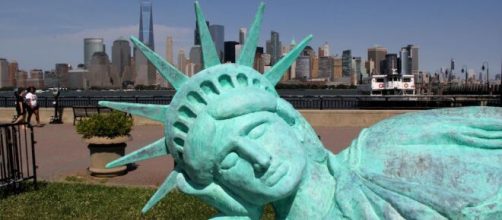Get a load of Lady Liberty as you’ve never seen her before – laying down on the job – no longer holding a torch above her head with one hand and the Declaration of Independence in the other.
Looks aren’t everything
Gone is the broken chain at her feet to signify freedom from slavery. In her prostrate form sculpted by Zaq Landsberg and retitled “Reclining Liberty,” she is not the welcoming symbol to immigrants we all know.
And instead of her usual 150-foot height, Landsberg cut her down to size – to 25 feet. So, doesn’t that look like a political statement?
It certainly seems that way. But that’s not the case.
"It’s just in there as is," Landsberg told the press about a display of “Reclining Liberty” at the Red Hook gallery in Brooklyn. The statue has also appeared in Harlem’s Morningside Park and the Liberty State Park in Jersey City.
“It’s just in there as is”? Even when Landsberg added that his sculpture shows “all the love, all the wear, and tear,” he wasn’t referring to the actual statue that has weathered time since it was unveiled on Liberty Island in 1886.
By “all the wear and tear,” Landsberg meant all the hands that touched his statue when it showed in New York and New Jersey. He didn’t comment on what the original statue stands for, let alone what his copy posed prone suggests.
Yet, Landsberg not only replicates Lady Liberty’s form but he also coated it with copper paint and oxidizing acid to further the resemblance, as if it had also weathered the sea air at Liberty Island for 136 years.
According to the cosmic principle
To hear Landsberg tell it, the Statue of Liberty has nothing to do with his statue. He said he got his inspiration from a statue known as “Reclining Buddha” made in the 2nd century.
Given that information, it follows that “Reclining Liberty” lies in a state of nirvana, neither suffering nor desiring. In other words, "Reclining Liberty" Lady Liberty is not laying down on the job. She has no job.
Is that what you see when you look at Landsberg’s statue – a Buddhist philosophy?
Doesn’t the close resemblance of his statue to the Statue of Liberty insinuate more? Doesn’t the flattened figure smack of surrender, of giving up on the idea of freedom from oppression?
And in this frame of mind, my thoughts go to other famous statuary that could be re-posed to speak to issues of our day, too. I’m thinking of the Lincoln Memorial.
Given Landsberg’s skill at replicating, how about taking the 16th president out of his throne-like chair and out of that Neoclassical temple he presides in?
The sculptor might sit Lincoln on the steps of his Memorial, say, with his head in his hand, to speak of his grief over the killing of black Americans and the effort by some states to limit minority voting.
My apologies to Daniel Chester French who designed Lincoln’s figure, to the Piccirilli brothers who carved it out of marble, and to architect Henry Bacon who planned the temple-look of the Memorial.
This is only to say that Landsberg could be on to something and not know it: re-forming statuary from history to speak for now.


